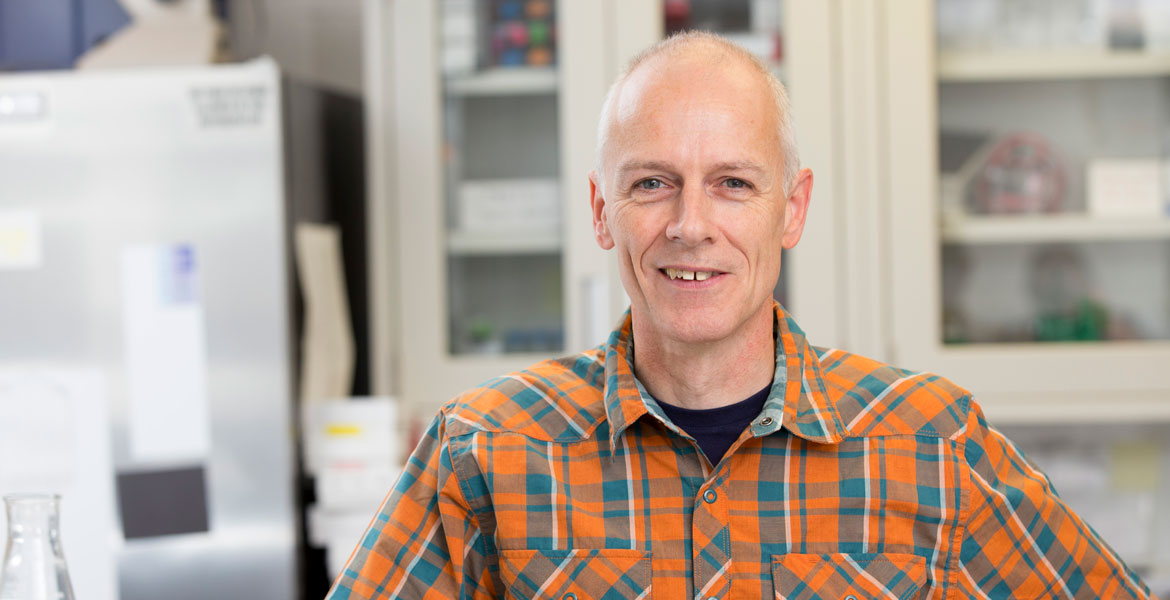
Vet Med Faces of Research: Dr. Tom Oomens
Monday, June 1, 2020
Tom Oomens, Ph.D., associate professor in the Department of Veterinary Pathobiology at Oklahoma State University College of Veterinary Medicine, is searching for a vaccine to battle respiratory syncytial virus or RSV, a very common human virus.
“If you look at children from age 0 to 5, across the world there are estimated to be 44 million cases of acute respiratory illness,” said Oomens. “Of those 44 million cases, 3 to 4 million are hospitalized with severe bronchiolitis and/or pneumonia. Of those, 70,000 to 200,000 children age 0 to 5 die every year. In the U.S. when you look at hospitalizations in the age group of 0 to 5, you’ll find that 20 percent of all hospitalizations are due to this one virus. So it’s a very significant respiratory virus, and there is no vaccine.”
In addition, Dr. Oomens said the virus has a big impact on the elderly.
“It is a virus that is very cunning in blocking the ability of its host, which in this case is us, to make a good immune response so this virus keeps pestering us throughout our lives. As a result, you get RSV-associated respiratory disease throughout your life, although healthy adults typically experience only cold-like symptoms. It’s recently been realized that there’s a big impact on the elderly with up to 10,000 elderly people dying every year from RSV in the U.S. alone.
“The potential impact my research can have on human health is probably the biggest overall excitement for me. If we make some breakthroughs and they contribute to a vaccine, the impact on world-wide health is enormous. That’s an important driving factor for me.”
In Oomens’ research lab the RSV research takes two directions.
“Viruses have a coat so to speak,” he explained. “A layer on the outside that virologists call an envelope. In the envelope are proteins embedded, which we have studied for a long time. We study the role that these proteins play in virus replication, how the virus goes in and out of cells, and also how these proteins impact the immune response. The second big area we focus on is how to translate all of that knowledge that we gain into vaccines.”
Developing that vaccine may be getting closer. Oomens is working in collaboration with Robert Welliver, Sr., M.D., professor of pediatrics at the Children’s Hospital at University of Oklahoma Health Sciences Center who has developed a baboon model for RSV.
“There are no good animal models so this is a big asset,” said Oomens. “Dr. Welliver has been looking into some of my vaccines and recently he received a National Institutes of Health grant to look into how to best deliver the vaccines to the lungs of animals.
“So far we have been funded to do mostly live-attenuated vaccine work. However, it’s not clear which vaccine approach is going to be the best approach, nor whether different ages need different vaccines. Therefore, we are also looking into different approaches that may help us to tailor vaccines to different age groups. Recently we obtained new NIH funding to do work on viruses that are not live but are inactive.”
Oomens’ colleagues at the College of Veterinary Medicine have been researching shipping fever in cattle, a disease complex to which bovine RSV contributes.
“We have a lot of expertise in the college on bovine respiratory disease. Bovine RSV contributes to this and is the cattle equivalent of human RSV. By having developed promising vaccine approaches for humans, we are now beginning to see if we can translate these approaches into the veterinary world by looking at bovine RSV and testing it in calves.
“Research careers are very exciting. They do require dedication, a critical mind and stamina,” he said. “It’s a career you can combine very well with academia if you’re interested in supervising students and teaching. It is also very easily applied to a more product-oriented approach if you want to work for a company. One of the best things is you are sort of like a detective. It’s a never ending detective story of finding new leads that take you to the next step.
“If there were one thing I could tell people about biomedical research: I would like to make the public more aware of how long it takes in the biomedical world to come up with a safe cure, how dedicated many of my research colleagues are in trying to find cures for a disease, and also how much funding it takes to get to that point. In the U.S. most of infectious disease research is funded by the National Institutes of Health. In Oklahoma we also have the Oklahoma Center for the Advancement of Science and Technology, which helps a lot of budding scientists tackle important problems and technologies. These funding sources are extremely important to keep biomedical research pushing forward to actually discover cures for medical problems such as RSV.”
If you would like to support research at the OSU College of Veterinary Medicine, please contact Ashley Hesser, assistant director of development with the OSU Foundation, at ahesser@osugiving.com or 405-385-0715.
MEDIA CONTACT: Taylor Bacon | Public Relations and Marketing Coordinator | 405-744-6728 | taylor.bacon@okstate.edu
